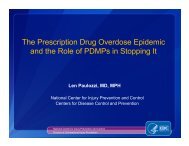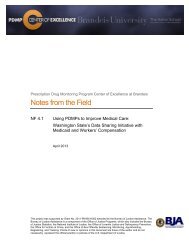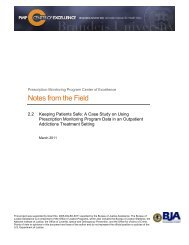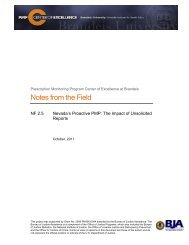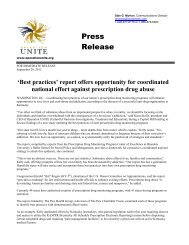Prescription Drug Monitoring Programs - PDMP Center of Excellence
Prescription Drug Monitoring Programs - PDMP Center of Excellence
Prescription Drug Monitoring Programs - PDMP Center of Excellence
Create successful ePaper yourself
Turn your PDF publications into a flip-book with our unique Google optimized e-Paper software.
<strong>Prescription</strong> <strong>Drug</strong> <strong>Monitoring</strong> <strong>Programs</strong>: An Assessment <strong>of</strong> the Evidence for Best Practices 26<strong>PDMP</strong> COE analyses <strong>of</strong> de-‐identified data from states neighboring Georgia identified zip codes withinGeorgia where Georgia prescribers were issuing unusually large numbers <strong>of</strong> prescriptions for controlledsubstances (Carnevale & Associates and <strong>PDMP</strong> COE, 2010). This information enabled Georgia <strong>of</strong>ficials toidentify possible pill mills within their state borders, even before their <strong>PDMP</strong> was enacted into state law.These examples suggest that <strong>PDMP</strong>s are a rich but underutilized resource for surveillance andevaluation efforts aimed at preventing prescription drug abuse and overdose. To assess the range <strong>of</strong>application <strong>of</strong> <strong>PDMP</strong> data beyond providing prescription history reports, states could be surveyed on thetypes <strong>of</strong> further analyses they produce and the end users receiving the prescriptions.Barriers to adoption: Barriers to further analysis and dissemination include lack <strong>of</strong> <strong>PDMP</strong> resources;<strong>PDMP</strong>s’ lack <strong>of</strong> familiarity with such analytical methodologies; the absence <strong>of</strong> working relationshipsbetween <strong>PDMP</strong>s and state and community organizations that could benefit from access to the analyzeddata, e.g., substance abuse prevention groups; and state restrictions on reporting to or collaboratingwith outside research organizations.SummaryRationale: Epidemiological analyses can assist in drug abuse surveillance, evaluation, and preventionefforts.Evidence <strong>of</strong> effectiveness: Unpublished data analyses.Current adoption status: Several <strong>PDMP</strong>s have provided analyses for communities and state agencies.Barriers to adoption: Insufficient program resources or expertise to carry out analyses, absence <strong>of</strong>cooperative working relationships between <strong>PDMP</strong>s and other groups, and restrictions on providing datato researchers.E. Develop automated expert systems to expedite analyses and reportsRationale and evidence <strong>of</strong> effectiveness: Reliable and valid analysis <strong>of</strong> <strong>PDMP</strong> data to identifyquestionable activity, track prescribing trends, and conduct other research <strong>of</strong>ten involves multiple stepsand requires familiarity with prescription information (e.g., drug classifications, standard doses, dataambiguities) gained over years <strong>of</strong> personal hands-‐on experience. Automated expert systems that captureat least some <strong>of</strong> this expertise may increase the speed and accuracy <strong>of</strong> such analyses and theirreporting, freeing up staff time and program resources for other initiatives. Automated systems can alsogenerate unsolicited reports and alerts based on criteria <strong>of</strong> questionable activity (see B. Determine validcriteria for possible questionable activity, above). Given that those meeting such criteria sometimesnumber in the thousands, automated algorithms to reliably identify such individuals and generate alertsto their prescribers and pharmacists may be the only feasible means to conduct proactive reporting on thenecessary scale. Research is needed to document existing <strong>PDMP</strong> expert systems, evaluate theirefficiencies, and help develop s<strong>of</strong>tware programs and standard algorithms that reliably identify probablequestionable activity and accelerate other analyses. Given the wide application <strong>of</strong> expert systems inother public health and safety contexts, it seems likely that <strong>PDMP</strong>s would gain in effectiveness byadopting automated procedures in analyzing and reporting their data.



